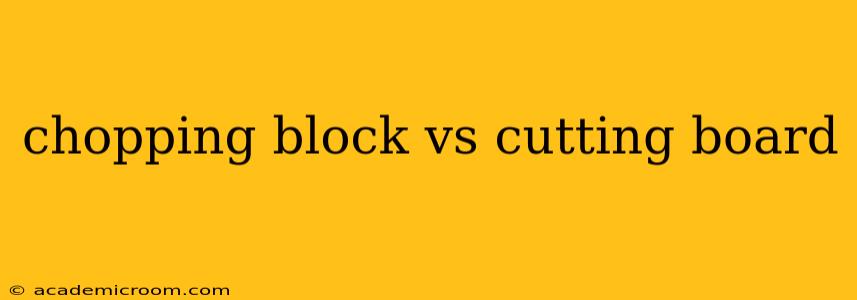Choosing between a chopping block and a cutting board can feel overwhelming. Both serve the purpose of protecting your countertops and providing a stable surface for food preparation, but their differences in material, size, and durability significantly impact their suitability for various cooking styles and needs. This guide will delve into the key distinctions to help you make an informed decision.
What is a Chopping Block?
A chopping block is typically a large, heavy, and sturdy cutting surface, often made from hardwood like end-grain maple or beech. Its substantial weight provides exceptional stability, minimizing movement during vigorous chopping tasks. The end-grain construction, where the wood grain runs perpendicular to the cutting surface, creates a self-healing surface that resists damage and dulls knives less quickly than edge-grain boards. Chopping blocks are known for their longevity and rustic charm, often becoming heirloom pieces in the kitchen.
What is a Cutting Board?
Cutting boards encompass a much broader range of materials, sizes, and styles. They are generally smaller and lighter than chopping blocks and come in various materials, including wood (edge-grain or end-grain), plastic, bamboo, and even glass or marble. While some cutting boards offer significant durability, they often lack the stability and self-healing properties of a well-made chopping block. The choice of material significantly affects its lifespan, hygiene, and suitability for different tasks.
Chopping Block vs. Cutting Board: Key Differences
Here's a breakdown of the key differences to help you decide which is right for you:
Size and Weight:
- Chopping Block: Typically large and heavy, offering superior stability.
- Cutting Board: Varies greatly in size and weight, ranging from small, lightweight plastic boards to larger, heavier wooden options.
Material:
- Chopping Block: Usually made from dense hardwood (end-grain) offering durability and knife-friendliness.
- Cutting Board: Available in a wide variety of materials, each with its own pros and cons regarding durability, hygiene, and maintenance.
Durability:
- Chopping Block: Highly durable, especially end-grain varieties, withstanding heavy use and resisting damage.
- Cutting Board: Durability varies widely depending on the material. Plastic boards are prone to scratches and warping, while wooden boards require proper care to prevent cracking.
Stability:
- Chopping Block: Exceptionally stable due to its weight and size.
- Cutting Board: Stability depends on size, weight, and the surface it rests on. Smaller boards can move during chopping.
Maintenance:
- Chopping Block: Requires regular oiling to maintain its condition and prevent drying and cracking.
- Cutting Board: Maintenance varies depending on the material. Plastic boards can be cleaned easily, while wooden boards may require more care to prevent bacterial growth.
What are the advantages of a chopping block?
A chopping block offers several advantages:
- Superior Stability: Its weight and size provide an incredibly stable work surface.
- Durability: A well-made chopping block can last for decades, even with heavy use.
- Self-Healing Properties (End-Grain): End-grain chopping blocks have a self-healing quality that minimizes knife damage and extends their lifespan.
- Aesthetic Appeal: They add a rustic charm and visual interest to the kitchen.
What are the advantages of a cutting board?
Cutting boards offer these advantages:
- Variety of Materials: Provides options for various budgets, needs, and aesthetics.
- Portability: Smaller cutting boards are easily moved and stored.
- Ease of Cleaning (some materials): Plastic and some other materials are easier to clean and sanitize than wood.
- Cost: Plastic cutting boards are typically more affordable than chopping blocks.
Which is better for me?
The best choice depends entirely on your needs and preferences.
- Choose a chopping block if: You need a highly stable, durable, and long-lasting surface for frequent and heavy-duty chopping. You appreciate its rustic look and don’t mind the extra maintenance involved.
- Choose a cutting board if: You require a more portable and versatile option, prefer a specific material (like plastic for easy cleaning), or have a smaller budget.
Ultimately, many home cooks benefit from having both a chopping block for heavy-duty tasks and a smaller, more manageable cutting board for everyday use. Consider your cooking habits, available space, and budget when making your decision.
